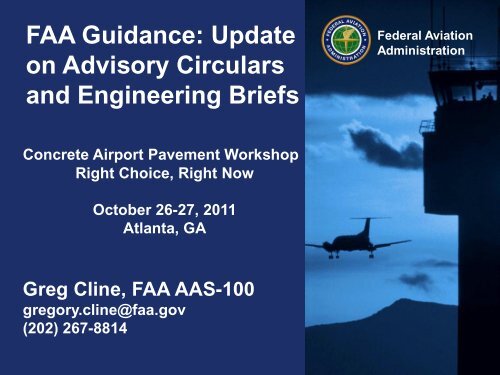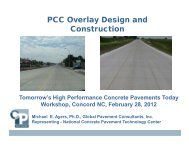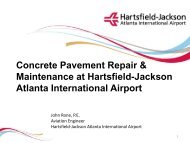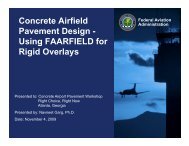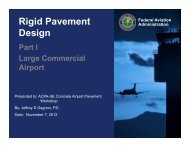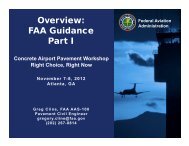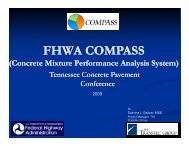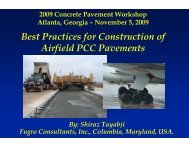FAA Guidance - American Concrete Pavement Association
FAA Guidance - American Concrete Pavement Association
FAA Guidance - American Concrete Pavement Association
- No tags were found...
You also want an ePaper? Increase the reach of your titles
YUMPU automatically turns print PDFs into web optimized ePapers that Google loves.
Presentation ObjectivesAnnouncement Indicated ―<strong>FAA</strong> Priorities‖ 2008 <strong>FAA</strong> <strong>Pavement</strong> Design: AC 150/5320-6E – <strong>FAA</strong>RFIELDComplete Review of Design and new procedures including:3-Dimensional Finite Element model; Gear Naming Convention;Cumulative Damage Factor (CDF) replaces design aircraft procedure 2009 <strong>Concrete</strong> Airfield <strong>Pavement</strong> Design - Using <strong>FAA</strong>RFIELD forRigid Design 2010 Using P-501 to Specify <strong>Concrete</strong> <strong>Pavement</strong>Federal AviationAdministration1
Presentation Objectives <strong>FAA</strong> Airports Safety & Standards Engineering Division Provide information on the Advisory Circular (AC) andEngineering Brief (EB) processes <strong>Guidance</strong> available on the Airports internet web site. Summarize AC and EB work in AAS-100 Recent Updates and Changes Significant since“2010 Using P-501 to Specify <strong>Concrete</strong> <strong>Pavement</strong>” Priorities and Direction for FY12 and BeyondFederal AviationAdministration2
Airport Engineering Division AAS-100• Division Manager• Assistant Manager (primarily for Airports GIS)• Administrative Assistant• National Resource Expert on Air Space• 7 Civil Engineers (2 pavements)• 3 Electrical/Electronics Engineers• ACRP Research Engineer (Mechanical)• Airport Safety Data Program (Program Manager)• Airports GIS (Computer Scientist)• Technical Support Contractor (ISI)• Technical Editor (shared)Federal AviationAdministration3
<strong>FAA</strong> <strong>Guidance</strong>• <strong>FAA</strong> guidance is part of the authorizing legislationfor airport development using Federal funds.• <strong>FAA</strong> airport design, construction, and maintenanceguidance are contained in Advisory Circulars, the150’s series.• Interim <strong>FAA</strong> airports engineering guidance isprovided in Engineering Briefs.• <strong>FAA</strong> airport guidance is available from <strong>FAA</strong> websites : http://www.faa.gov/arp/Federal AviationAdministration4
What Delays a Change• Non-Concurrence from HQ Offices.• Non-Concurrence from <strong>FAA</strong> Regions.• Inability to Reconcile Comments from Boeing,ACC, Peer Review <strong>Association</strong>s, or Industry.• Substantive Alterations to a Proposed ChangeMay Require New Draft.Federal AviationAdministration6
Technical Support / Contractor Work• Large Portion of the Work Performed bySupport Contract (ISI beginning FY11)• <strong>FAA</strong> specialist prepares statement of work,contractor gets clarification, then delivers draft.• <strong>FAA</strong> specialist circulates for review.• <strong>FAA</strong> and contractor finalize document.• <strong>FAA</strong> legal review, Office Director signs.Federal AviationAdministration7
Airports Web SiteFederal AviationAdministration8
Airports Web SiteFederal AviationAdministration9
http://www.faa.gov/airports/engineering/Federal AviationAdministration10
Federal AviationAdministration11
Federal AviationAdministration12
Federal AviationAdministration13
Advisory Circular Web SiteFederal AviationAdministration14
http://www.faa.gov/http://www.faa.gov/airports/http://www.faa.gov/airports/engineering/http://www.faa.gov/airports/resources/advisory_circulars/Federal AviationAdministration15
2010 New and Revised <strong>FAA</strong> AirportsSeries 150 Advisory Circulars (ACs)150/5340-30E Design and Installation Details for Airport Visual Aids150/5000-16 Announcement of Availability of the Guide for Private Flyers – U.S.International Airports150/5200-35A Submitting the Airport Master Record in Order to Activate a New Airport150/5210-23 ARFF Vehicle and High Reach Extendable Turret (HRET) Operation, Trainingand Qualifications150/5210-24 Airport Foreign Object Debris (FOD) Management150/5220-17B150/5345-10G150/5345-3G150/85210-13C150/5345-12F150/5345-44J150/5340-1K150/5345-51B150/5340-18FAircraft Rescue and Fire Fighting (ARFF) Training FacilitiesSpecification for Constant Current Regulators and Regulator MonitorsSpecification for L-821, Panels for the Control of Airport LightingAirport Water Rescue Plans and EquipmentSpecification for Airport and Heliport BeaconsSpecification for Runway and Taxiway SignsStandards for Airport Markings New/Revised Comments:Errata Sheet for AC 150/5340-1K (September 23, 2010)Specification for Discharge-Type Flashing Light EquipmentStandards for Airport Sign SystemsNew/Revised Comments Errata Sheetfor AC 150/5340-18F16Federal AviationAdministration
Recent Past Work - Completed AC‘s150/5070-6B , Airport Master Plans, Change 1,(5/1/2007)150/5320-5C, Surface Drainage Design, Change 1(9/30/2008)150/5345-45C, Low-Impact Resistant (LIR) Structures,(4/6/2007)150/5300-13, Airport Design, Change 16,(01/03/2011)Federal AviationAdministration17
Recent Past Work - Completed AC‘s150/5200-37, Introduction to Safety ManagementSystems (SMS) for Airport Operators, 2/28/2007150/5320-12C, Measurement, Construction, andMaintenance of Skid-Resistant Airport <strong>Pavement</strong>Surfaces, Change 8, 2/7/2007150/5190-6, Exclusive Rights at Federally-ObligatedAirports, 1/4/2007Federal AviationAdministration18
FY11 Complete, Continue, Start Work5100-14 Architectural, Engineering, and Planning Consultant Services for Airport Grant Projects5200-18 Airport Safety Self-Inspection5200-32 Reporting Wildlife Aircraft Strikes5210-06 Aircraft Fire and Rescue Facilities and Extinguishing Agents5210-20 Ground Vehicle Operations on Airports5210-22 Airport Certification Manual (ACM)5220-04 Water Supply Systems for Aircraft Fire and Rescue Protection5220-17 Design Standards for an Aircraft Rescue and Fire Fighting Training Facility5220-20 Airport Snow and Ice Control Equipment5220-21 Guide Specification for Devices Used to Board Airline Passengers with Mobility Impairments5220-22 Engineered Materials Arresting Systems (EMAS) for Aircraft Overruns5220-25 Avian Radar5230-04 Aircraft Fuel Storage, Handling, and Dispensing on Airports5300-13 Airport Design5300-17 IMAGERY5300-18 SURVEYS5300-19 AIRPORT DATA5340-30 DESIGN AND INSTALLATION DETAILS5345-28 Precision Approach Path Indicator (PAPI) Systems5345-47 Isolation Transformers for Airport Lighting Systems5345-53 Airport Lighting Equipment Certification Program5360-12 Airport Signing and Graphics5360-14 Access to Airports By Individuals With Disabilities5370-02 Operational Safety on Airports During Construction5390-2B HELIPORT DESIGN5395-01 Seaplane BasesFederal AviationAdministration19
FY11 Continue – ‗Complete‘5335-5B STANDARD METHOD FOR REPORTING AIRPORT PAVEMENTSTRENGTH (PCN) [8/31/2011]5370-10F STANDARD FOR SPECIFYING CONSTRUCTION OF AIRPORTS [AGC]5370-15B AIRSIDE APPLICATIONS FOR ARTIFICIAL TURF [9/30/2011]5370-17 AIRSIDE USE OF HEATED PAVEMENT SYSTEMS [3/29/2011]5370-11B USE OF NONDESTRUCTIVE DEVICES IN THE EVALUATION OFAIRPORT PAVEMENTS [9/30/2011]5100-13B DEVELPOMENT OF STATE STANDARDS FOR NONPRIMARYAIRPORTS [8/31/2011]5380-08A HANBOOK FOR IDENTIFICATION OF ALKALI-SILICA REACTIVITY INAIRFIELD PAVEMENTS CANCELLED5300-13 AIRPORT DESIGN CHANGE 17 [9/30/2011][Date Published]Federal AviationAdministration20
Engineering Briefs (EB)• Interim <strong>FAA</strong> guidance is provided inEngineering Briefs. EB’s provide additionalguidance on unusual conditions that AC’smay not completely address.• Generally issued without draft sent out forwidespread review.• Also placed on the Airports web site.Federal AviationAdministration21
http://www.faa.gov/airports/engineering/engineering_briefs/Federal AviationAdministration22
FY10 Engineering Briefs EB83 In <strong>Pavement</strong> Light Fixture Bolts EB81 Use of <strong>Guidance</strong> for Runway Centerlineto Parallel Taxiway/Taxilane CenterlineSeparation for Boeing 747-8(rev. 3/17/2010 to correct wingspan of B747-8 in section B) EB80 Use of Interim Taxiway Edge SafetyMargin Clearance for Airplane Design Group VI(posted 3/15/2010)Federal AviationAdministration23
Recent ‗<strong>Pavement</strong>‘ Engineering BriefsEB70 Accelerated Alkali-Silica Reactivity in PortlandCement <strong>Concrete</strong> <strong>Pavement</strong>s Exposed to Runway DeicingChemicals December 13, 2005DRAFT EB7X Rejuvenation Product Qualification Procedureand Requirements-Draft (Comment period extended to5/1/2007)DRAFT EB 68 Four Component Coal-Tar SealerRejuvenator (Not Suitable for Project Use at this Time).Issued For Comment: August 10, 2005 EB 66 Rubblized Portland Cement <strong>Concrete</strong> BaseCourse February 13, 2004Federal AviationAdministration24
Recent ‗<strong>Pavement</strong>‘ Engineering Briefs EB 62 Polymer Composite Micro-Overlay for Fuel-Resistant Wearing SurfacesDecember 20, 2002EB 60 Semi-Flexible Wearing Course for Apron <strong>Pavement</strong>January 16, 2001 EB 59A Engineering Brief No. 59A, Item P-401 Plant MixBituminous <strong>Pavement</strong>s (Superpave). This Brief Provides<strong>Guidance</strong> on Using Asphaltic Mixtures Designed UsingSuperpave Techniques (Supercedes EB59 3/1/00, 12/01guidance)May 12, 2006Federal AviationAdministration25
Recent ‗<strong>Pavement</strong>‘ Engineering Briefs EB 57 Extended Q-Value Table for Estimating Percent ofLot Within Limits (Pwl) Q-Value and PWL TableMay 19, 1999 EB 56 Development of Revised Acceptance Criteria forItem P-401 and Item P-501.January 27, 1999 EB 44 Coal-Tar Sealer/Rejuvenator (Updated 5/29/2008) 11/2/1989• EB44A Cancelled• EB44B Revised Coal-Tar Sealer/RejuvenatorSpecification (Supersedes specification attached toNovember 2, 1989, brief) May 21, 2008Federal AviationAdministration26
FY11 – FY14 Work – <strong>Pavement</strong> + EBs With materials and processes in the pavement construction industryhaving significantly changed in the past 30 years and coupled withcomputer technology and advances in information technology transfer,many EBs are out-of-date or simply obsolete. Therefore, to eliminate orreduce confusion from misleading information easily obtained frominternet search engines from these EBs, all EBs are to be reviewed forverification of reliable information and cross-referenced with applicableACs and either update if needed, cancel and remove do to beingobsolete, or cancel and archive to internal archives (non-searchablethrough internet search engines).Perform this review in increments of decades per year. In other words areview and recommend action on all EBs dated in the 1970’s to becompleted FY11, 1980’s in FY12, 1990’s in FY13, and 2000’s in FY14EB01-EB21 (FY11)EB22-EB-44 (FY12)EB45-EB58 (FY13)EB59-EB79 (FY14)27Federal AviationAdministration
Recent Updates and ChangesSpecify <strong>Concrete</strong> <strong>Pavement</strong> Using P-501Airport <strong>Pavement</strong> Strength (PCN)Federal AviationAdministration28
FY11 Continue – ‗Complete‘5335-5B STANDARD METHOD FOR REPORTING AIRPORT PAVEMENTSTRENGTH (PCN) [8/31/2011]5370-10F STANDARD FOR SPECIFYING CONSTRUCTION OF AIRPORTS [AGC]5370-15B AIRSIDE APPLICATIONS FOR ARTIFICIAL TURF [9/30/2011]5370-17 AIRSIDE USE OF HEATED PAVEMENT SYSTEMS [3/29/2011]5370-11B USE OF NONDESTRUCTIVE DEVICES IN THE EVALUATION OFAIRPORT PAVEMENTS [9/30/2011]5100-13B DEVELPOMENT OF STATE STANDARDS FOR NONPRIMARYAIRPORTS [8/31/2011]5380-08A HANBOOK FOR IDENTIFICATION OF ALKALI-SILICA REACTIVITY INAIRFIELD PAVEMENTS CANCELLED5300-13 AIRPORT DESIGN CHANGE 17 [9/30/2011][Date Published]Federal AviationAdministration29
<strong>FAA</strong> AC 150/5370-10FSTANDARD FOR SPECIFYINGCONSTRUCTION OF AIRPORTSItem P-501 Portland Cement <strong>Concrete</strong> <strong>Pavement</strong>EB70 Accelerated Alkali-Silica Reactivity in Portland Cement<strong>Concrete</strong> <strong>Pavement</strong>s Exposed to Runway Deicing ChemicalsDecember 13, 2005AC 150/5380-08A HANBOOK FOR IDENTIFICATION OF ALKALI-SILICA REACTIVITY IN AIRFIELD PAVEMENTSFederal AviationAdministration30
<strong>FAA</strong> AC 150/5370-10FSTANDARD FOR SPECIFYINGCONSTRUCTION OF AIRPORTSItem P-501 Portland Cement <strong>Concrete</strong> <strong>Pavement</strong>EB70 Accelerated Alkali-Silica Reactivity in Portland Cement<strong>Concrete</strong> <strong>Pavement</strong>s Exposed to Runway Deicing ChemicalsDecember 13, 2005AC 150/5380-08A HANBOOK FOR IDENTIFICATION OF ALKALI-SILICA REACTIVITY IN AIRFIELD PAVEMENTSFederal AviationAdministration31
Item P-501 Portland Cement <strong>Concrete</strong> <strong>Pavement</strong>P-501 and P-610: Updates information on testing protocol ofaggregate for reactivity and use of cementitious materials related toreactivity requirements(1) 501-2.1 and 610-2.1: Reactivity tests will be tested for expansionat 28-days (30-days from casting).(2) 501-2.1: Deleted Engineers Note referring to Engineering BriefNo. 70.(3) 501-2.3 and 610-2.6: Additional requirements added for use ofClass F fly ash when mitigating alkali-silica reactivity and deleteduse of Class C fly ash.(4) 501-3.2: Deleted first sentence in Engineers Note afterparagraph b.Federal AviationAdministration32
Item P-501 Portland Cement <strong>Concrete</strong> <strong>Pavement</strong>501-2.1 AGGREGATES.a. Reactivity. Aggregates shall be tested for deleterious reactivity with alkalis in the cement, which may cause excessiveexpansion of the concrete. Separate tests of coarse and fine aggregate shall be made in accordance with ASTM C1260. If the expansion of coarse or fine aggregate test specimens, tested in accordance with ASTM C 1260, does notexceed 0.10 % at 28 days (30 days from casting), the coarse or fine aggregates shall be accepted.If the expansion of any aggregate, coarse or fine, at 28 days is greater than 0.10%, tests of combined materials shall bemade in accordance with ASTM C 1567 using the aggregates, cementitious materials, and/or specific reactivity reducingchemicals in the proportions proposed for the mixture design. If the expansion of the proposed combined materials testspecimens, tested in accordance with ASTM C 1567, does not exceed 0.10 % at 28 days, the proposed combinedmaterials will be accepted. If the expansion of the proposed combined materials test specimens is greater than 0.10% at28 days, the aggregates will not be accepted unless adjustments to the combined materials mixture can reduce theexpansion to less than 0.10 % at 28 days, or new aggregates shall be evaluated and tested.Separate tests of coarse and fine aggregate using ASTM C 1260If both do not exceed 0.10% at 28 days, aggregates acceptedIf coarse or fine > 0.10% at 28 days, tests combined materials includingaggregate, cementitious materials, and admixes Using ASTM C 1567If does not exceed 0.10% at 28 days, combination of materials acceptedFederal AviationAdministration33
Item P-501 Portland Cement <strong>Concrete</strong> <strong>Pavement</strong>501-2.3 CEMENTITIOUS MATERIALSa. Flyash or Natural Pozzolan. Flyash shall meet the requirements of ASTM C618, Class F or N with the exception of loss of ignition, where the maximum shallbe less than 6 percent. [The following tests in Supplementary Optional PhysicalRequirements of Table 3 contained in ASTM C 618 shall apply: Select theappropriate tests when project specific conditions or exposures dictate (Increaseof drying shrinkage of mortar bar); (Effectiveness in Contributing to SulfateResistance Procedure A) or (Effectiveness in Contributing to Sulfate ResistanceProcedure B). Select either sulfate resistance test, but not both.] Class F or Nflyash for use in mitigating alkali-silica reactivity shall have a Calcium Oxide(CaO) content of less than 13 percent and a total equivalent alkali content lessthan 3 percent. Flyash such as is produced in furnace operations using limingmaterials or soda ash (sodium carbonate) as an additive shall not be acceptable.The Contractor shall furnish the previous three most recent, consecutive ASTMC-618 reports for each source of flyash proposed in the mix design, and shallfurnish each additional report as they become available during the project. Thereports can be used for acceptance or the material may be tested independentlyby the Engineer.Federal AviationAdministration34
Item P-501 Portland Cement <strong>Concrete</strong> <strong>Pavement</strong>501-2.3 CEMENTITIOUS MATERIALSa. Flyash or Natural Pozzolan. Flyash shall meet the requirements of ASTM C618, Class F or N with the exception of loss of ignition, where the maximumshall be less than 6 percent. [The following tests in Supplementary OptionalPhysical Requirements of Table 3 contained in ASTM C 618 shall apply: Selectthe appropriate tests when project specific conditions or exposures dictate(Increase of drying shrinkage of mortar bar); (Effectiveness in Contributing toSulfate Resistance Procedure A) or (Effectiveness in Contributing to SulfateResistance Procedure B). Select either sulfate resistance test, but not both.]Class F or N flyash for use in mitigating alkali-silica reactivity shall have aCalcium Oxide (CaO) content of less than 13 percent and a total equivalent alkalicontent less than 3 percent. Flyash such as is produced in furnace operationsusing liming materials or soda ash (sodium carbonate) as an additive shall not beacceptable. The Contractor shall furnish the previous three most recent,consecutive ASTM C-618 reports for each source of flyash proposed in the mixdesign, and shall furnish each additional report as they become available duringthe project. The reports can be used for acceptance or the material may betested independently by the Engineer.Federal AviationAdministration35
Item P-501 Portland Cement <strong>Concrete</strong> <strong>Pavement</strong>501-2.3 CEMENTITIOUS MATERIALSa. Flyash or Natural Pozzolan. Flyash shall meet the requirements of ASTM C618, Class F or N with the exception of loss of ignition, where the maximumshall be less than 6 percent. [The following tests in Supplementary OptionalPhysical Requirements of Table 3 contained in ASTM C 618 shall apply: Selectthe appropriate tests when project specific conditions or exposures dictate(Increase of drying shrinkage of mortar bar); (Effectiveness in Contributingto Sulfate Resistance Procedure A) or (Effectiveness in Contributing toSulfate Resistance Procedure B). Select either sulfate resistance test, butnot both.] Class F or N flyash for use in mitigating alkali-silica reactivity shallhave a Calcium Oxide (CaO) content of less than 13 percent and a totalequivalent alkali content less than 3 percent. Flyash such as is produced infurnace operations using liming materials or soda ash (sodium carbonate) as anadditive shall not be acceptable. The Contractor shall furnish the previous threemost recent, consecutive ASTM C-618 reports for each source of flyashproposed in the mix design, and shall furnish each additional report as theybecome available during the project. The reports can be used for acceptance orthe material may be tested independently by the Engineer.Federal AviationAdministration36
Item P-501 Portland Cement <strong>Concrete</strong> <strong>Pavement</strong>501-2.3 CEMENTITIOUS MATERIALSa. Flyash or Natural Pozzolan. Flyash shall meet the requirements of ASTM C618, Class F or N with the exception of loss of ignition, where the maximumshall be less than 6 percent. [The following tests in Supplementary OptionalPhysical Requirements of Table 3 contained in ASTM C 618 shall apply: Selectthe appropriate tests when project specific conditions or exposures dictate(Increase of drying shrinkage of mortar bar); (Effectiveness in Contributing toSulfate Resistance Procedure A) or (Effectiveness in Contributing to SulfateResistance Procedure B). Select either sulfate resistance test, but not both.]Class F or N flyash for use in mitigating alkali-silica reactivity shall have aCalcium Oxide (CaO) content of less than 13 percent and a total equivalentalkali content less than 3 percent. Flyash such as is produced in furnaceoperations using liming materials or soda ash (sodium carbonate) as an additiveshall not be acceptable. The Contractor shall furnish the previous three mostrecent, consecutive ASTM C-618 reports for each source of flyash proposed inthe mix design, and shall furnish each additional report as they become availableduring the project. The reports can be used for acceptance or the material maybe tested independently by the Engineer.Federal AviationAdministration37
Item P-501 Portland Cement <strong>Concrete</strong> <strong>Pavement</strong>501-2.3 CEMENTITIOUS MATERIALSa. Flyash or Natural Pozzolan.******************************************************************************Class C flyash may be proposed on a case-by-case basis whereinnocuous aggregates are used and the pavement is not subjectedto airfield pavement de-icers. Any use of Class C flyash is subjectto the approval of the engineer and <strong>FAA</strong>. A modification tostandards will be required.*******************************************************************************Federal AviationAdministration38
Item P-501 Portland Cement <strong>Concrete</strong> <strong>Pavement</strong>501-3.4 TESTING LABORATORY. The laboratory used to develop the mix designshall meet the requirements of ASTM C 1077. The laboratory accreditation willinclude ASTM C 78. A certification that it meets these requirements shall besubmitted to the Engineer prior to the start of mix design. The certification shallinclude evidence that the laboratory is inspected/accredited for the test methodsrequired herein by a nationally recognized laboratory inspection accreditationorganization.Federal AviationAdministration39
Item P-501 Portland Cement <strong>Concrete</strong> <strong>Pavement</strong>501-3.4 TESTING LABORATORY. The laboratory used to develop the mix designshall meet the requirements of ASTM C 1077. The laboratory accreditation willinclude ASTM C 78. A certification that it meets these requirements shall besubmitted to the Engineer prior to the start of mix design. The certification shallinclude evidence that the laboratory is inspected/accredited for the test methodsrequired herein by a nationally recognized laboratory inspection accreditationorganization.501-3.4 CONCRETE MIX DESIGN LABORATORY. The Contractor’slaboratory used to develop the concrete mix design shall meet therequirements of ASTM C 1077. The laboratory accreditation must becurrent and listed on the accrediting authority’s website. All test methodsrequired for developing the concrete mix design must be listed on the labaccreditation. A copy of the laboratory’s current accreditation andaccredited test methods shall be submitted to the Engineer prior to startof construction.Federal AviationAdministration40
<strong>FAA</strong> AC 150/5335-5BSTANDARD METHOD FOR REPORTINGAIRPORT PAVEMENT STRENGTH (PCN)The standardized method, known as the Aircraft Classification Number –<strong>Pavement</strong> Classification Number (ACN-PCN) method, has been developed andadopted as an international standard and has facilitated the exchange of pavementstrength rating information.Definition of ACN. ACN is a number that expresses the relative effect of an aircraftat a given configuration on a pavement structure for a specified standard subgradestrength.Definition of PCN. PCN is a number that expresses the load-carrying capacity ofa pavement for unrestricted operations.System Methodology. The ACN-PCN system is structured so a pavement with aparticular PCN value can support an aircraft that has an ACN value equal to orless than the pavement’s PCN value. This is possible because ACN and PCNvalues are computed using the same technical basis.Federal AviationAdministration41
AC 150/5335-5A ―STANDARDIZED METHOD OFREPORTING AIRPORT PAVEMENT STRENGTH –PCN‖• The <strong>Pavement</strong> Classification Number (PCN) fieldhas been added to <strong>FAA</strong> Form 5010 and datacollection is underway.• During each airport inspection, the airport ownerwill be asked to provide runway PCN information.• This means the Aircraft Gross Weight fields onthe 5010 will no longer be used to describe loadcarrying capacity of runways.Federal AviationAdministration
AC 150/5335-5A …PCNGross Weight datamay transition.PCN data request now partof all airport inspections• The Master Record is required to be updatedperiodically. PCN is now mandatory and GrossWeight data will possibly be phased out with time.Federal AviationAdministration
<strong>FAA</strong> <strong>Guidance</strong> on PCN Calculation• 2005 – The PCN field was re-activated inthe Form 5010 Database.• September, 2006 - AC 150/5335-5A“Standardized Method of ReportingAirport <strong>Pavement</strong> Strength – PCN” wasreleased to standardize the proceduresfor computing and reporting PCN valuesfor inclusion in the 5010 database.(Complete re-write of AC 150/5335-5.)Federal AviationAdministration
<strong>FAA</strong> <strong>Guidance</strong> on PCN Calculation• AC 150/5335-5A was based in large parton the procedures described in BoeingReport D6-82203 “Precise Methods forEstimating <strong>Pavement</strong> ClassificationNumber,” 1998.• D6-82203 is, in turn, based in large parton recommendations contained in theICAO Aerodrome <strong>Pavement</strong> DesignManual dated 1983.Federal AviationAdministration
AC 150/5335-5B, Changes from -5A• The procedure for selecting the critical aircraft hasbeen substantially revised.• The procedure used in AC 150/5335-5A forcomputing equivalent departures has been replacedby a procedure based on cumulative damage factor(CDF).• Except for obtaining the structure and aircraftproperties, the procedure has been completelyautomated in a revised version of the computerprogram COM<strong>FAA</strong>, now version 3.0.• A spreadsheet application has been developed tofacilitate determining the evaluation thickness andorganizing the PCN results.Federal AviationAdministration
ACN-PCN – Technical EvaluationBasic Steps to Determine <strong>Pavement</strong> Classification Number1) Identify pavement features and properties.2) Determine traffic mixture.3) Convert traffic to equivalent traffic of “critical” aircraft.4) Determine maximum allowable operating weight ofcritical airplane.5) Determine ACN of critical airplane at maximum allowableoperating weight.6) Repeat with each airplane set as the critical airplane.7) Report PCN.Federal AviationAdministration
<strong>FAA</strong> AC 150/5335-5BSTANDARD METHOD FOR REPORTING AIRPORTPAVEMENT STRENGTH (PCN)Federal AviationAdministration48
<strong>FAA</strong> 150/5370-11B USE OF NONDESTRUCTIVE DEVICESIN THE EVALUATION OF AIRPORT PAVEMENTSThis advisory circular (AC) focuses on nondestructive testing (NDT) equipmentthat measures pavement surface deflections after applying a static ordynamic load to the pavement.Principal Changes.Since the previous revision, the <strong>FAA</strong> has developed andimplemented the pavement design program <strong>FAA</strong>RFIELD. Chapter 8- NDT-BASED EVALUATION AND DESIGN INPUTS is updated toreflect the requirements of <strong>FAA</strong>RFIELD rather than the previousdesign program LED<strong>FAA</strong>.Federal AviationAdministration49
Priorities and DirectionFY12 and BeyondFY12 Work – <strong>Pavement</strong> ACsONE Standard Guide Specification forAirfield <strong>Pavement</strong>Design Life for Airfield <strong>Pavement</strong>20 years to 40 yearsFederal AviationAdministration50
FY12 Work – <strong>Pavement</strong> ACs~ initial consideration ~Circular Updates will be limited in number as we go through the learning curve of implementing SMS5370-10G STANDARD AND SPECIFYING CONSTRUCTION OFAIRPORTS5370-11C USE OF NONDESTRUCTIVE DEVICES IN THEEVALUATION OF AIRPORT PAVEMENTS5380-06C GUIDELINES AND PROCEDURES FORMAINTENANCE OF AIRPORT PAVEMENTS5320-17 AIRFIELD PAVEMENT SURFACE EVALUATION ANDRATING (PASER) MANUALS5380-07 PAVEMENT MANAGEMENT SYSTEMFederal AviationAdministration51
ONE Standard Guide Specification forAirfield <strong>Pavement</strong>Consideration of Changing Existing Advisory Circular Format to theConstruction Specifications Institute (CSI) Format and following /adopting Unified Facilities Guide Specifications (UFGS) format.Include all Parts of AC 150/5370-10Informal discussions with <strong>FAA</strong> personal, Airport ConsultantsCouncil (ACC), ASCE T&DI Airfield <strong>Pavement</strong> Committee, andrepresentatives from the <strong>Concrete</strong> and Asphalt <strong>Association</strong>sOngoing efforts of Tri-Service / <strong>FAA</strong> Airfield <strong>Pavement</strong>s EngineersFormal meetings during the Annual Meeting at TRBFederal AviationAdministration52
Design Life for Airfield <strong>Pavement</strong>20 years to 40 yearsFederal AviationAdministration53
Design Life for Airfield <strong>Pavement</strong>20 years to 40 years AIP Funding Regulations and Law Design parameters and <strong>FAA</strong>RFIELDPast report: PCC & HMA similar and > 20 year life (SCI)~ Perform similar type evaluation for 40 yr life Serviceability - Maintenance and ManagementPast report: PCC & HMA not similar indicating pavement service lifelimiting (PCI) – HMA attacked by sun and rain~ Performance Modeling & Analysis- Build on previous work completed through ONR~ Implement Preservation- Review Funding Issues and AIP Regulations- New and Existing HMA <strong>Pavement</strong> Surface(i.e. Gilsonite Modified Asphalt Emulsion Sealer Binder)Federal AviationAdministration54
Thank YouQuestions / DiscussionAirport Engineering Division, AAS-100Greg ClineJeff Rapol202-267-8814 202-267-7474gregory.cline@faa.govjeffrey.rapol@faa.govFederal AviationAdministration55
AC 150/5335-5B, Spreadsheet (by Jeff Rapol)Federal AviationAdministration
AC 150/5335-5B, Spreadsheet—Flexible InputFederal AviationAdministration
AC 150/5335-5B, Spreadsheet—Flexible OutputFederal AviationAdministration
AC 150/5335-5B, COM<strong>FAA</strong> 3.0Federal AviationAdministration
COM<strong>FAA</strong> 3.0 – Aircraft WindowFederal AviationAdministration
AC 150/5335-5B, COM<strong>FAA</strong> InputFederal AviationAdministration
AC 150/5335-5B, Computer Programs—COM<strong>FAA</strong> OutputCOM<strong>FAA</strong> generates aircraft ACN table.CBR 9 indicates B subgradedesignation• PCN based on using aircraft ACN can bereported as 54.Federal AviationAdministration
AC 150/5335-5B, Computer Programs—COM<strong>FAA</strong> OutputCOM<strong>FAA</strong> generates table based onCDF method. Allowable gross weightand corresponding PCN are identified.CBR 9 indicates Bsubgrade designationFederal AviationAdministration
AC 150/5335-5B, Computer Programs—COM<strong>FAA</strong> Output• CDF method identifies (3) aircraft that contributesubstantial structural damage based on pavementstructure: 727-200,747-400, and A300-B4.• PCN based on technical CDF method can be reportedas the highest PCN of these aircraft = 73.Federal AviationAdministration
Flexible <strong>Pavement</strong> ThicknessAircraft Gross Weight, lbs. (thousands)AC 150/5335-5B, Computer Programs—COM<strong>FAA</strong> OutputAC 150/5335-5B Table A1-8 Example40 in.35 in.30 in.25 in.1,2001,000800• CompareThicknessand GrossWeights.20 in.15 in.10 in.5 in.0 in.1. 6D thickness at traffic mix GW 25.7 25.7 25.5 27.5 28.8 23.12. CDF thickness at max. GW 33.2 31.4 32.0 29.5 29.3 27.53. Evaluation thickness fromequivalent pavement4. Max.Allowable Aircraft GWfrom CDF33.8 33.8 33.8 33.8 33.8 33.8378,172 365,637 643,712 442,946 993,243 253,9855. Aircraft GW from traffic mix 370,000 330,000 600,000 370,000 820,000 185,000``767-200 ER DC8-63 777-200 A300-B4 747-400 727-2006004002000• When CDFthickness isless thanEvaluationthickness,excess PCNis available.Most Demanding Aircraft in Traffic MixFederal AviationAdministration
Subgrade code= B at CBR= 9.0, t= 33.8Annual DeparturesAC 150/5335-5B, Computer Programs—COM<strong>FAA</strong> OutputAC 150/5335-5B Table A1-8 ExamplePCN= 90PCN= 80PCN= 70PCN= 60PCN= 50PCN= 40PCN= 30PCN= 20PCN= 10PCN= 045474957 5752 521. Aircraft ACN at traffic mix GW 45.2 48.8 51.5 52.3 53.9 48.22. Calculated PCN at CDF max.GW3. Annual Departures fromtraffic mix767-200 ER DC8-63 777-200 A300-B4 747-400 727-20046.6 56.7 56.9 68.1 70.6 72.82,000 800 300 1,500 3,000 40068547148733,5003,0002,5002,0001,5001,0005000• PCNneeded forusingtraffic is 54.• PCN basedon CDFanalysiscan bereported ashigh as 73.Most Demanding Aircraft in Traffic MixFederal AviationAdministration


